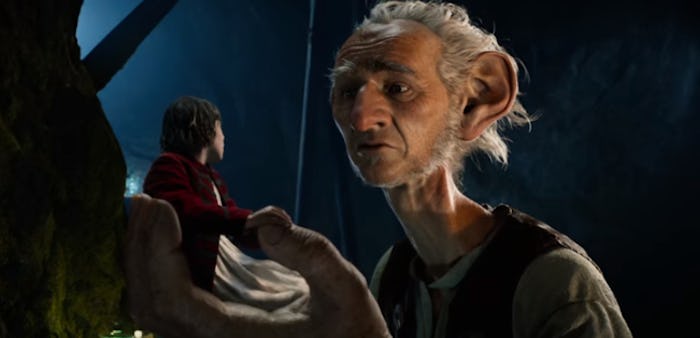Entertainment
How Did They Make 'The BFG' Giant Big? Bringing Him To Life Was A High-Tech Project
Another classic by beloved children’s author Roald Dahl is moving from imagination to reality as The BFG (also known as The Big Friendly Giant) hits theaters this weekend. There are plenty of reasons for Dahl fans to get excited about the film adaptation — I mean, simply placing Dahl’s adventure story in the hands of legendary filmmaker Steven Spielberg seems like a can’t-lose venture. But one important reason for Dahl fans to look forward to the movie is that it seems, according to the trailer at least, to pay appropriate homage to the imagery and fantasy that came together to make Dahl’s signature style. Take the Big Friendly Giant, for example. How did Spielberg manage to capture a character that has lived so vividly in readers’ minds? And exactly how’d they make the The BFG giant... big?
The simple answer, of course, is through the magic of computer animation. Much like the process of transforming actor Andy Serkis into Gollum in the Lord of The Rings movies, the filmmakers relied on a combination of tiny cameras, green screens, and computer-generated graphics to create the beloved, grandfatherly character, according to the Chicago Tribune. Essentially, Spielberg and his team relied on Mark Rylance, the Tony-award winning actor behind Spielberg’s The BFG, to bring the character to life — then the animation team went about the intricate task of digitally “erasing” Ryland himself and creating a “full-color illustration” of the 24-foot tall giant.
Still, even by Hollywood standards, bringing the Big Friendly Giant to life was technically pretty complicated. For starters, Spielberg and his team had to visualize an entire world for the giants to inhabit. In his interview for MetroNews Canada, actor Daniel Bacon (who plays the giant named Bonecruncher) said that — in a process typical for movies with heavy CGI animation — the actors didn’t have many physical cues around during filming.
“It was a big empty space and you had to use your imagination to feel the different elements,” Bacon told MetroNews. “There was tape on the floor and it was explained that something would be here, and something would be there. We relied on Steven telling us and being very descriptive about what it would look like.”
Michael Adamwaithe, who played the giant named the Butcher Boy, told MetroNews that even though the actors were placed in a near-empty studio, Spielberg kept them focused on what the final work would look like to audiences:
For all the locations there was a big concept art poster and then there was the virtual camera which is technologically way beyond my brain power, but it is so crisp and the technology has advanced so quickly that now we are at a point that even though we were in a carpeted room with tape on the floor we had the benefit of being able to look over to a large screen monitor and see these almost real time, almost full renderings of our characters.
Early reviews for the movie have applauded both Ryland’s interpretation of the giant and the animators’ efforts at creating an entire fantasy world based on Dahl’s book. That’s quite a big accomplishment, considering that, for decades, Dahl fans have imagined how the Big Friendly Giant might move and sound, based on the book’s illustrations and Dahl’s incredible writing.
With Spielberg’s version opening this Friday, it’ll be interesting to see whether the high-tech version meets the mark. Either way, The BFG really does look like a must-see experience.
